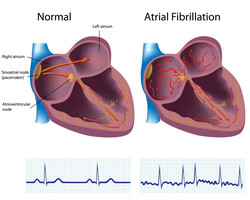The molecular aetiology of cardiac arrhythmia
AF is the most common cardiac arrhythmia and currently there are no efficient treatments. AF is associated with abnormal calcium release by the sarcoplasmic reticulum (SR) in human atrial myocytes (HAMs). However, the precise aetiology behind this observation remains unknown. With this in mind, scientists on the EU-funded AF IN HUMAN MYOCYTES (Effects of atrial fibrillation on the distribution and frequency of spontaneous calcium release events in human atrial myocytes) project hypothesised that this altered calcium release is due to changes in the activity and distribution of the SR calcium release channel (RyR2) or in proteins that modulate its activity. For this purpose, they studied RyR2 expression and phosphorylation in HAMs from patients with or without AF. They observed no difference in the density of RyR2 in myocytes from patients with AF, but an increase in the phosphorylated form of the receptor was evident. This could explain the increase in calcium sparks seen in AF myocytes. Further investigation of the downstream signalling events indicated that in AF, cAMP-dependent regulation of the L-type calcium current was reduced. In addition, emerging evidence suggests that the spontaneous calcium release from the SR in AF is associated with the adenosine A2A receptor. In this context, this study tested how A2AR activation affected the beat-to-beat stability at increasing stimulation frequencies. Researchers observed that A2AR activation destabilised the beat-to-beat stability of intracellular calcium homeostasis, and its prevention might be a novel way to maintain the response of HAMs during elevation of the beating rate. Furthermore, an increased SR calcium load was seen in cases of post-operative AF, the most common complication associated with open-heart surgery. Since age is a confounding factor of AF, scientists also tested the hypothesis that ageing per se altered calcium handling in the human atrium. They observed significant reductions in SR calcium content and handling in older subjects but no changes in spontaneous calcium release. Taken together, project data highlight the physiological changes that may favour a progressive decline in right atrial function. These findings should help in designing more effective preventive and therapeutic strategies.







